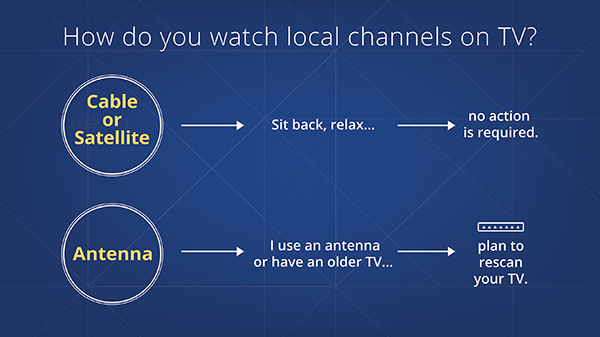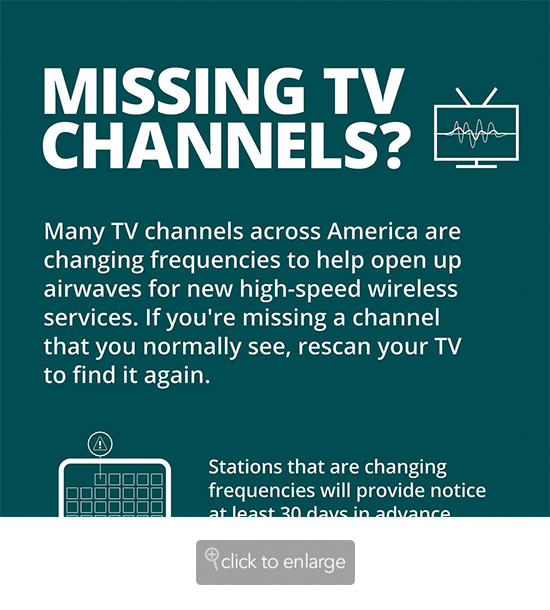(Family Features) If you rely on a rooftop or indoor antenna for your TV viewing, changes that may affect your local channels are happening.
The Federal Communications Commission (FCC) is making more airwaves available for new high-speed wireless services and, as a result, some over-the-air TV broadcast frequencies will change.
“Some TV stations across the nation are changing frequencies to help make airwaves available to meet ever-growing consumer demand for high-speed mobile broadband services such as 5G,” said Jean Kiddoo, FCC incentive auction task force chair. “The channel numbers on the TV are not changing, but viewers who use a rooftop or indoor antenna need to rescan their televisions to continue receiving those channels. The process is the same as when viewers first connected their TVs to the antennas and scanned them to find local channels, and the FCC has resources to help viewers who may need assistance.”
Viewers who watch TV with antennas need to rescan their TVs, but don’t need to buy new TVs or purchase converter boxes. Cable and satellite subscribers are not affected by these changes.
The frequency changes are happening on a rolling basis through July 2020, so not all changes will happen at the same time. TV stations will give you at least 30 days’ notice that their channels are changing frequency. You should be on the lookout for announcements by your local channels on when to rescan, and if you notice a channel you normally watch is missing, try rescanning in case you missed the notice.
Common Transition Questions

How will I know it’s time to rescan?
Some local TV channels will change frequencies at various times through mid-2020. Your local TV stations will announce their specific “rescan days” on which you will need to rescan. You should be on the lookout for public service announcements and “crawls” running across your TV screen. Broadcasters will provide at least 30 days’ notice that their channel is changing frequency.
A good rule of thumb is to rescan your TV anytime you notice a missing channel. If you haven’t rescanned in a while, you may be surprised by how many other channels are now available.
Who will be affected by the transition?
People who watch television with an antenna will be affected. Millions of consumers across the country watch free, over-the-air TV using an antenna. Cable and satellite subscribers will not need to take any action.
Will channel numbers change?
No, the channel numbers you see on your TV are not changing, but you will need to rescan your television to update it to find the new frequencies so you can continue receiving those same local channels.
How can I find out which TV stations are changing frequencies?
The FCC website has an interactive map where you can insert your zip code to see which of your local TV channels will be changing and the dates during which you should be watching for the station to announce its “rescan day.” To access the map, visit fcc.gov/media/engineering/dtvmaps.
Why are frequencies changing?
The frequency changes are making more airwaves available to meet the demand of American consumers and businesses for increased mobile broadband capacity, new 5G wireless and other advanced high-speed mobile services currently being developed.
How can I find more information?
For more information and tips on how to rescan, visit fcc.gov/TVrescan or call 1-888-CALLFCC (1-888-225-5322) and choose option No. 6.
How to Rescan Your TV
Rescanning your TV to receive the new frequencies is the same process you used to find your local channels when you first set up your TV.
To rescan, look in your TV remote control’s “menu” for “channel scan,” “program,” “rescan,” “auto tune” or “auto search” in the “setup” or “channel” function.
Even without these frequency changes, it is typically a good idea to periodically rescan your TV to update the channels you receive since local stations sometimes add new “sub-channels” to their programming. While some TVs do this automatically, you may need to select “scan” or “auto-tune” from the TV menu to start the scanning process.
If you have difficulty, consult your TV owner’s manual or call the manufacturer’s customer service line for more detailed instructions on how to run a channel scan to find local TV channels. If you need to contact customer service, you can find that information in your TV owner’s manual or on the manufacturer’s website.
Once the rescan is complete, you should receive all available digital TV channels through your antenna. Except in rare circumstances, no new equipment or services are required.
For more information and tips on how to rescan, visit fcc.gov/TVrescan or call 1-888-CALLFCC (1-888-225-5322).
Photo courtesy of Getty Images (family watching TV)
Source:
Federal Communications Commission








